A la recherche de mes foules, j'ai trouvé
par hasard un autobus. Ce n'était pas jaune. Il n'y avait pas
d'écoliers dedans, ni de chauffeur. En fait, il n'y avait personne. Aucune
trace, aucun empreinte. Il était blanc et couvert de neige. Ça a rappelé « Les Américains »
de Robert Frank mais à l'envers, et cette impression m'a frappé : on dit que
nous sommes "américains", nous aussi, mais qu'est-ce que cela veut
dire, être citoyen d'un pays? Est-ce possible être citoyen en isolation?
Quelles universalités est-ce qu'on partage sinon les villes qu'on habite?
On dit "habiter" une ville mais la ville vous habite-vous «possède»-aussi, mais pas jusqu’à ce que vous marchez ses rues, écoutez ses murmures et apprenez de près ses subtilités. Est-ce qu'on habite donc tous le même pays? Est-ce que c'est le même pays qui nous habite, qui nous possède?
SLC
SLC
SLC
Springville
“To walk is to lack a place. It is the indefinite process of being absent and in search of a proper. The moving about that the city mutliplies and concentrates makes the city itself an immense social experience of lacking a place -- an experience that is, to be sure, broken up into countless tiny deportations (displacements and walks), compensated for by the relationships and intersections of these exoduses that intertwine and create an urban fabric, and placed under the sign of what ought to be, ultimately, the place but is only a name, the City...a universe of rented spaces haunted by a nowhere or by dreamed-of places.”
― Michel de Certeau, The Practice of Everyday Life
― Michel de Certeau, The Practice of Everyday Life









J'aime bien la première photo dans cet essaie. Je pense que la composition est belle. Cela me fait penser à Nouveau Topographiques et Lewis Baltz, parce que c'est très plat et il n'y a personne.
ReplyDeleteI think all of the pictures are really good. I especially like the one of the skateboarder and the one of the girl walking her dog while the statue is looking at her. However, I felt that each the first and the last perhaps didn't fit as well, because there are no people in them.
ReplyDeleteGreat photos! My favorite is probably of the man with the shopping cart. I can't really say why; I appreciate the way the trees frame his profile. It's as if he's lost and looking for directions in an unknown concrete jungle, or in life, or both. The de Certeau citation is a cool addition too that brings the idea of public space/place together.
ReplyDeleteI really liked the final text - I think it tied the essay together really well. I thought the picture with the house and the bike was my favorite - great form and very minimalist. However, I think the essay on the whole was unbalanced. There was one picture in Provo, one in Springville, and then seven in Salt Lake? I really liked the skateboarder, the homeless man, and the dog picture but I don't think the other photos added a whole lot to the essay.
ReplyDeleteJ’aime les formes géométriques, surtout dans les trois premières photos. Il y a des lignes et des repétitions qui rendent les photos intéressantes. Même avec le skateboarder, les petits triangles créés par les poignées de portes ont attiré mon attention.
ReplyDelete